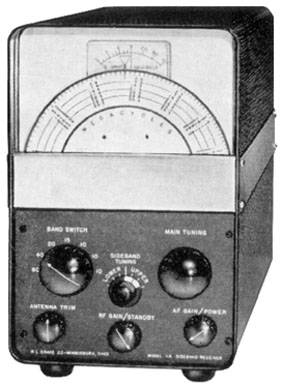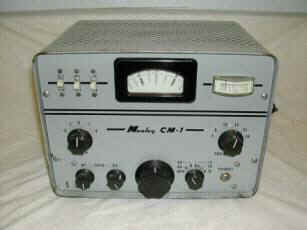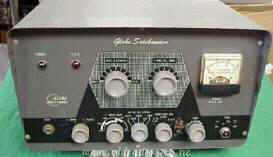K5LAD - 50 Years of Ham Radio Memories
Volume XXIII
My Memories of Early Day SSB
By Jim Pickett – K5LAD
There had been SSB experimentation back in the late 40s and early 50s but it was later in the 60s before ham equipment manufacturers started building equipment that was intended and expected to be used for receiving SSB. Many years passed with hams using the old diode detectors which had worked so well for AM or Amplitude Modulation and was also being used for CW. It was in the late 50s when the product detector, made especially for detecting SSB, was designed into the receiver. Until then, the user set up their receiver to copy SSB just like they did for copying CW, that is, turn the RF gain control all the way down, turn the AVC (automatic volume control) switch off, and turn the AF gain control all the way up. The audio level (volume) was then controlled with the RF gain control knob. This system worked OK until the introduction of the product detector, which was a perfect decoding match for SSB.
|
The first commercial receiver with a product detector was the Drake 1A, a strange-looking receiver that was narrow and tall with a very deep cabinet. In fact, the Drake 1A had only the product detector and to listen to an AM signal (and they were still in the majority) you had to zero-beat the AM signal to mask the whistle from the heterodyne produced. Unfortunately, at that time, the VFOs used on so many AM transmitters were unstable and would drift up or down during the transmission so that the ham receiving the signal needed to keep one hand on the receiver's tuning knob to follow the signal up or down the band. |
|
An interesting thing, not universally known, is that around this same time, Mosley Electronics offered a receiver that had some of the same features of the Drake 1A. Yes, that’s the same Mosley Electronics that designed and sold jillions of beams, verticals, and other assorted antenna products. The receiver, known as the CM-1 is shown in the attached picture and, as far as I know, was the company’s only attempt in branching out past their antenna product line. |
The original name for this type of transmission was SSBSC, which stood for “Single Side Band Suppressed Carrier”, and most of the articles written about it used the SSBSC name. Whereas AM was made up of a carrier on the actual frequency being transmitted with an upper and a lower sideband on either side of the carrier, the SSBSC eliminates and/or suppresses the carrier and one of the sidebands. The sidebands, which represented approximately 25% of the signal each, contained the actual audio information. Using CW, you only needed the carrier and keyed it on and off. Using SSBSC, the carrier was removed, typically by a phasing process and this left the two sidebands. Only one was needed to convey the audio information so one of the sidebands was removed, either by a phasing process or by using a tight crystal or mechanical filter. There's often a question of why is LSB or lower side band used on the bands 160, 80, and 40 but USB or upper side band was used on 20, 15, and 10 (the WARC bands didn't come along until the late 70s).
Just as an aside, many of the early day, homebrewed SSBSC transmitters (which only worked on 20 meters and 75 meters), used several small audio transformers made by the Lionel Train Corporation. These were easily identifiable by the logo with a large letter “L” with a circle around it. All of us who had played with our Lionel trains during our youth easily recognized that Lionel logo. Why would a toy manufacturer also manufacture and sell electronic audio transformers? I don’t know…….. perhaps diversification of company sales or maybe those transformers were earlier used in some product the Lionel Corporation also sold. I just always found that bit of information very interesting.
Interestingly enough, commercial SSBSC transmitters were fairly expensive during their early years but a company in Council Bluffs, Iowa called WRL came out with a transmitter, the Globe Sidebander DSB-100, which was DSBSC or Double Side Band Suppressed Carrier. As I recall, by having two identical tubes in the final with the plates connected in parallel for output and feeding the oscillator signal to the grids in push-pull and the audio to the screens in push-pull, it would cancel the carrier and leave only the two sidebands. Some thought it was a cheap substitute, and it actually was, but it was like getting an excellent price on a new car but you couldn't install a wheel on the end of one axle.
|
|
It was ALMOST recognizable sideband....... but not quite. The DSBSC was very hard to detect with standard receivers that lacked any tight filters in the signal path. The two sidebands were out of phase with each other and unless you could eliminate that other sideband, it was difficult to decode and understand. Unless you had a really expensive receiver, you just couldn't receive the signal worth a flip. If you could afford the expensive receiver, you could probably also afford the more expensive SSBSC transmitter so DSB never did ‘take off’. I don’t know how many of these DSB-100 units were made but it has been many years since I’ve seen one even available at a hamfest and I don’t think I’ve ever seen an ad for someone trying to find one, even for their collection. |
Besides the "quack quack" criticism of many hams (often the ones who swore they would NEVER give up their beautiful sounding AM for the new "sideband" stuff) there were many who refused to adopt this new mode of operation. No doubt, they were some of the same ones who were the last to give up spark and change over to CW. Some said, "You can't tune them in quickly enough to understand what they were saying." Certainly, the newcomer to listening to a SSB signal had to learn to tune a signal correctly. Mistuning would make the ham on the other end sound either too high-pitched or too low-pitched. Females and young users with naturally higher-pitched voices actually were harder to tune in but it was a matter of practicing and learning how to do it.
To stop the constant clicking from the VOX operation, many hams would add an "uhhhhhhhh" between sentences or while they were thinking of the next thing they wanted to say. This led some operators to sound like they weren't quite bright and provided the "anti-sideband crew" with some good reasons why they didn't want to get on this new mode (and give up their favorite old AM rig). It took many years for the ham population to get control of their speaking and lose their “uhhhhhhhhhhs” but I don’t hear that too much on the bands these days. Now “ya know” if we could “ya know” get the “ya know” sports heroes to “ya know” stop saying “ya know,” ya know, so many “ya know” times when they’re “ya know” being interviewed on “ya know” TV …………………ya know.
Now a days, it is seldom that you can listen on any of the regular HF bands (160-10 meters) and hear any voice/audio signal that is not single side band. Occasionally you can run across an AM signal from a ham trying to reclaim their youth and some FM operation is allowed on a part of the 10-meter band but SSB is, by far, the standard voice mode in use today. Just as flight has come so very far in a short 100 years, ham communications have also come a long way in the approximately same period of time.
Page visited 573 times


